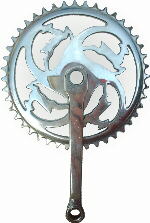 Gazelle chainset Gazelle chainset
|
Development of an industry
There used to be about 50 true bicycle
factories and thousands of bicycle brands in the Netherlands. Nowadays only a few of them
remain. Those who survived knew to acquire themselves a respectable position, especially
on the home market.
|
| The early years |
The history of the Dutch bicycle
industry from 1869 until today is as vicissitudinous as the past 130 years were in
general. Two pioneers of this development were J.T. Scholte who was one of the first, or
maybe the first to set up a bicycle trading business in Amsterdam, and Scholte's agent
H.H. Timmer. Timmer began selling and renting bicycles in 1869. He also founded the
first cyclists' riding school in the Netherlands. Timmer probably initialised the
foundation of the first Dutch bicycle works by selling a velocipede to Henricus Burgers, a
smith from Deventer. Burgers then went on to produce his own bicycles in 1869, thus
becoming the father of the Dutch bicycle industry.
|
This was a remarkable
step, as it took some 15 to 20 years before other large bicycle works were founded in
Holland. At that time the invention and development of the bicycle by mainly English
inventors was virtually complete. Some of the new Dutch manufacturers didn't only produce
their own bicycles but also kept the sales representation of an English brand. The English
bicycle industry had the strongest international market position, while the young Dutch
brands had not yet established a reputation.

In the beginning it was usually small blacksmiths and metal
industries that started making bicycles. In contrast, the pioneers in Germany and England
were often sewing machine factories. Later on bicycle repairmen and wholesale dealers
switched from bike assembly to bicycle manufacturing on a reasonably large scale. |
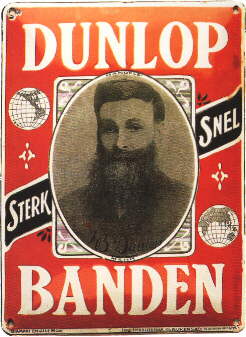 |
|
In the
1890's the Dutch bicycle industry grew rapidly. On December 17th 1893 the Association of
Dutch Bicycle Manufacturers was founded in Utrecht. When car manufacturers joined the
association - or bicycle manufacturers became car manufacturers - it was renamed to
"De Rijwiel- en Automobiel-Industrie" (RAI) in 1900.

Due to technical improvements bicycles became more and more
popular at the end of the 19th century. Despite economic problems in Holland, 1893 and
1895 were excellent years for the Dutch bicycle industry. In 1896 companies like Simplex,
Fongers and Burgers reacted with substantial expansions of their bicycle works. However,
imports still remained the most important factor in meeting the demands of the Dutch
market.

Prices began to decrease due to batch production and an
oversupply of bicycles from America. Whereas initially bikes were largely used for sport
and recreation, now that bicycles were becoming more affordable they rapidly gained in
popularity with the common folk as a standard means of transport. Tax data from that
period shows that the number of bicycles in the Netherlands doubled between 1899 and 1903
to 187,839. In the early years of the 20th century bicycle trading was a prosperous
business, and every year about 40,000 to 50,000 more bikes appeared on Dutch streets. In
1912 a total number of 646,925 bicycles was reached (along with 4,000 motorbikes and 3,250
cars). Export to European and non-European countries increased as well.
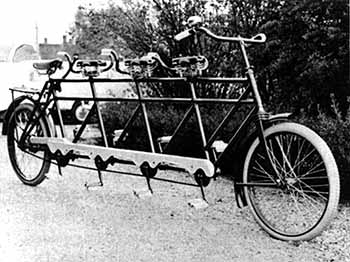
Gazelle quadruplette
|
| Between the two world wars |

Solar bicycle lamp -
" Often copied! Never equalled!"
|
Despite its neutrality,
the first world war caused economic problems to the Netherlands. Stagnating rubber supply
from the Dutch colony Indonesia soon lead to a prohibition of cycle tyre exports.
Particularly from 1917 onwards international trade became badly affected and raw materials
for production became very rare.

At the bottom of a price list of the Gruno brand from May
1919 there is still noted: "The above prices don't include tyres." One year
later, the same company proudly mentions at the top of its price list: "Bicycles with
tyres." |
| The end of the war on November the 11th, 1918 was a great
relief. But soon Dutch bicycle companies had a new problem to face: their German
competitors began selling very low priced bicycles on a large scale in Holland because the
German mark had devaluated and Dutch guilders were therefore sought-after. |
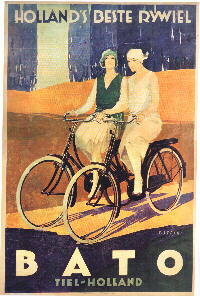 |
But nevertheless the
Dutch bicycle industry flourished in the post war years. According to tax data, in 1919
there were 861,500 bicycles in Holland while this number increased up to 1,756,738 in
1924.

The annual reports of the Dutch Chamber of Commerce of the
years 1922 to 1926 show quite negative expectations about crisis and strong international
competition, especially for the bicycle industry. But in 1927 times changed again with
some more good years ahead.

The twenties and thirties were apparently a very unstable
period. The economic recession coming from America in 1929, gradually affected European
countries as well, causing a downturn in Dutch bicycle production from that year on. The
production increased again after 1934, but consumers still didn't have much to spend.
Therefore bikes from the beginning of the thirties are often of lower quality. The crisis
didn't end until the year 1936. By 1939 the total number of bicycles reached 3,300,000. |
During the
war bicycle production in the Netherlands decreased considerably. Spare parts became
increasingly difficult to obtain. In 1941 a great shortage of bike-tyres began. In this
period many bicycle parts became increasingly scare and more and more alternative and
innovative 'crisis products' were produced such as wooden tyres, grips, pedal blocks,
carbide lamps and protective shields for bike lamps. During the last years of the war many
machines from bicycle factories were demolished or disassembled by the occupying German
forces and transported to Germany.

After the war it remained difficult to get bicycles and
spare parts. Nevertheless the well-known bicycle manufacturers soon started making
bicycles again. In order to meet the large demand, parts and bikes were imported in bulk
from England, Canada and the USA and often fitted with own transfers. |
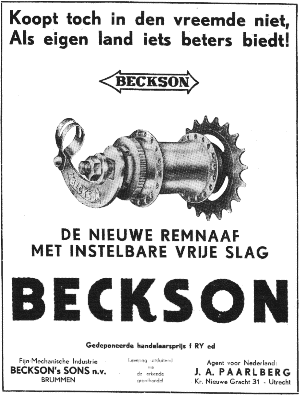
Post-war back-pedal brake
hub of Dutch manufacture
|
|
Copyright by
Herbert Kuner, © 1999 ...
All rights reserved.

Last update: 29/03/04
|